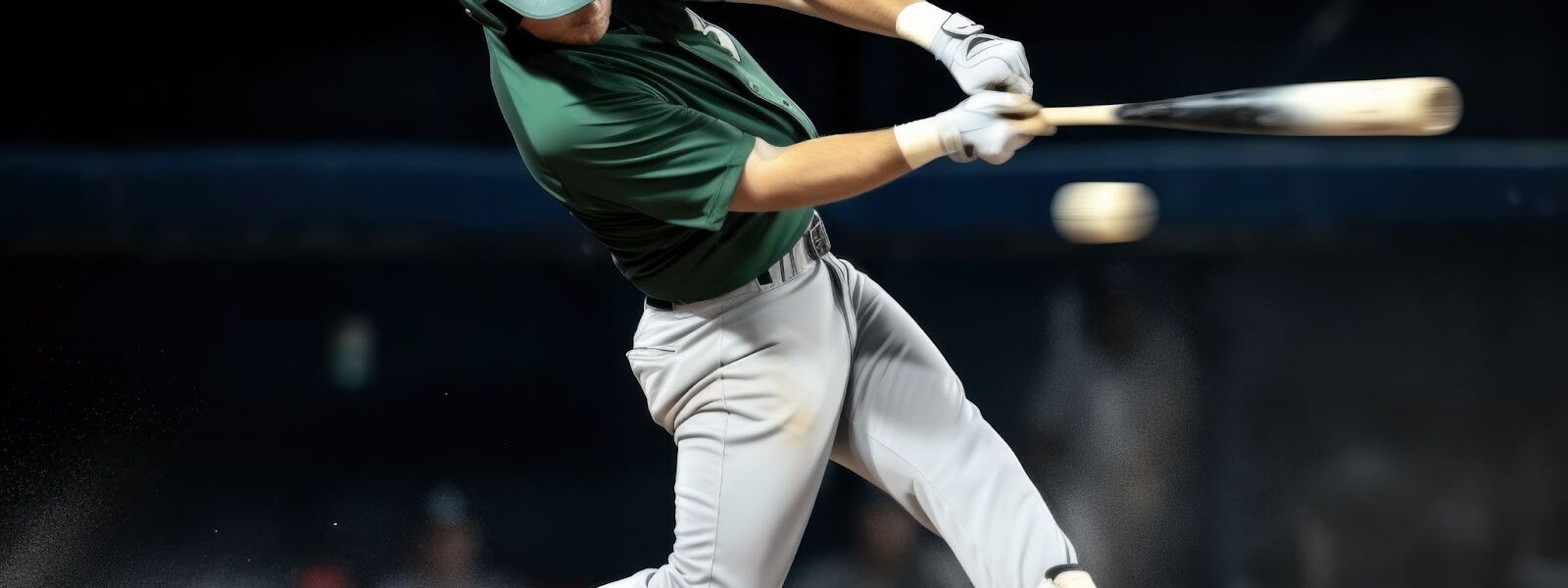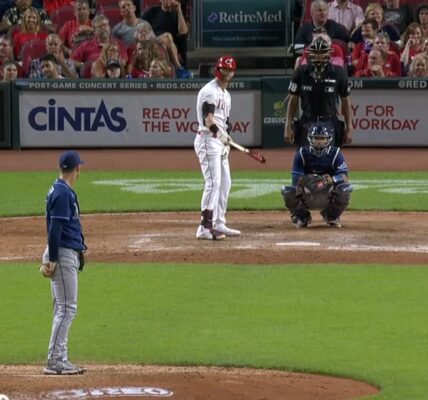In the realm of baseball, slugging percentage stands as a pivotal metric, gauging a batter’s prowess in wielding power at the plate. It’s a numerical expression achieved by dividing the aggregate number of bases accumulated by a batter by their total at-bats. Unlike the batting average, which assigns equal weight to all hits, slugging percentage bestows greater significance upon extra-base hits. Consequently, it unveils a more profound and nuanced understanding of a player’s batting aptitude. Now, let’s delve into the intricacies of how slugging percentage presents a comprehensive portrayal of a player’s impact on the offensive front.
Understanding Slugging Percentage: A Measure of Hitting Power
Slugging percentage is a baseball statistic that quantifies a player’s hitting power. The origin of the term is rooted in the word “slug,” which in baseball vernacular refers to a powerful hit. A player renowned for their ability to deliver such hits is commonly labeled as a “slugger.” This terminology underscores the nature of slugging percentage – it’s an index that captures the frequency and intensity of a player’s power-hitting capabilities. The higher the slugging percentage, the more proficient the player is at generating hits that yield multiple bases, showcasing their prowess at the plate.
Detailed Insights into Slugging Percentage
- Calculation Method: Slugging percentage is calculated by dividing the total number of bases a player earns from hits by the number of at-bats. This formula gives a numerical value reflecting the average number of bases a player achieves per at-bat;
- Power Hitting Indicators: A high slugging percentage is indicative of a player’s ability to hit the ball far and hard, often resulting in doubles, triples, and home runs. This metric goes beyond the batting average by not just accounting for hits, but the type of hits that contribute significantly to the team’s offensive strength;
- Comparative Analysis: By comparing slugging percentages, one can gauge the power-hitting ability of different players. It serves as a crucial tool for team managers and coaches in formulating game strategies and for scouts in evaluating potential talent;
- Strategic Implications: Players with a high slugging percentage are often strategically placed in the batting lineup to maximize scoring opportunities, especially in situations where extra-base hits can change the course of the game.
Understanding Slugging Percentage: Unveiling the Power Behind Baseball Stats
In the world of baseball statistics, one metric stands out for measuring a player’s raw power at the plate: the Slugging Percentage. Unlike the traditional batting average, slugging percentage takes a unique approach to gauge a batter’s effectiveness, emphasizing the impact of each hit rather than just their frequency. Let’s delve deeper into how this exciting statistic is calculated and its significance in the world of baseball. Also, explore the fascinating world of ERA in baseball – uncovering its true essence and significance in America’s favorite pastime.
The Anatomy of Slugging Percentage Calculation
Slugging percentage, often referred to as “SLG” among baseball enthusiasts, is a vital tool for evaluating a player’s ability to deliver powerful hits. It breaks down the total bases achieved by a batter and expresses them as a percentage of their at-bats (AB). Here’s how you calculate it:
Count the Total Bases (TB): To start, gather the following information about a batter’s performance:
- The total number of singles (1B);
- The number of doubles (2B);
- Triples (3B);
- Home runs (HR).
Assign Weighted Values: Each type of hit is assigned a weighted score in the calculation, reflecting its potential impact on the game:
- A single is not weighted (1B = 1);
- A double carries twice the weight (2B = 2);
- Triples have triple the weight (3B = 3).
- Home runs are the heavy hitters, with four times the weight (HR = 4).
Calculate the Slugging Percentage (SLG): Employ the formula: (1B + 2B x 2 + 3B x 3 + HR x 4) / AB. This equation encapsulates the essence of slugging percentage.
The Example of Babe Ruth’s Historic Slugging Percentage
Now, let’s put this knowledge into action by examining one of baseball’s legends, Babe Ruth, and his extraordinary slugging percentage during the historic 1920 season.
In 1920, Babe Ruth recorded an impressive 172 hits. Let’s break down his hits:
- 73 singles (1B);
- 36 doubles (2B);
- 9 triples (3B);
- An astonishing 54 home runs (HR).
To complete the calculation, we need the total number of at-bats (AB), which stood at 458 for Ruth in that season.
Now, let’s calculate Ruth’s slugging percentage step by step:
- Singles: 73 x 1 = 73;
- Doubles: 36 x 2 = 72;
- Triples: 9 x 3 = 27;
- Home Runs: 54 x 4 = 216.
Add these weighted bases together: 73 + 72 + 27 + 216 = 388
Now, divide this total by Babe Ruth’s at-bats: 388 / 458 ≈ 0.847
Babe Ruth’s slugging percentage for the 1920 season was an astounding 0.847.
Understanding the Essence of Slugging Percentage in Baseball
Slugging percentage is a critical metric in baseball, acting as a barometer for a player’s hitting power. Unlike the batting average, which simply accounts for hits, the slugging percentage gives weight to the type of hits. It’s a more comprehensive measure, providing insights into a player’s ability to generate extra-base hits.

Influences on Slugging Percentage
- Player’s Hitting Style:
- Contact Hitters: These players typically focus on making contact with the ball, aiming for consistent but not necessarily powerful hits. Consequently, they tend to have lower slugging percentages due to fewer extra-base hits;
- Power Hitters: Players known for their strength and ability to hit the ball farther, often leading to more home runs and extra-base hits. These athletes generally boast higher slugging percentages, reflecting their capacity for impactful hits;
- Quality of Pitching: The skill level of opposing pitchers can significantly affect a batter’s slugging percentage. Facing top-tier pitchers may result in a lower slugging percentage.
- Ballpark Factors: The dimensions and altitude of a ballpark can influence hitting, thereby impacting a player’s slugging percentage.
Benchmarks of Slugging Percentage
- Baseline for Competence (~.450): A slugging percentage around .450 is considered proficient, indicating a batter’s adequate power-hitting abilities;
- Mark of Excellence (~.550): Players reaching a slugging percentage of .550 are seen as outstanding hitters, showcasing a significant level of power and consistency;
- Elite Status (~.650 and above): Achieving a slugging percentage over .650 places a player in an elite category, underscoring exceptional power-hitting prowess;
- Below Average (<.350): On the flip side, a slugging percentage below .350 is generally viewed as subpar, suggesting a need for improvement in hitting power.
Exploring the Elite Slugging Percentage Leaders in Baseball History
When it comes to measuring a baseball player’s offensive prowess, slugging percentage (SLG) is a key metric. It quantifies a player’s ability to produce extra-base hits and is a testament to their power and consistency at the plate. Let’s delve into the world of slugging percentage leaders in baseball history and uncover the remarkable careers of some of the most iconic players to have graced the diamond.
| Rank | Player | SLG |
|---|---|---|
| 1 | Babe Ruth | 0.6897 |
| 2 | Ted Williams | 0.6338 |
| 3 | Lou Gehrig | 0.6324 |
| 4 | Mule Suttles | 0.6179 |
| 5 | Turkey Stearnes | 0.6165 |
| 6 | Oscar Charleston | 0.6145 |
| 7 | Jimmie Foxx | 0.6093 |
| 8 | Barry Bonds | 0.6069 |
| 9 | Hank Greenberg | 0.605 |
| 10 | Mark McGwire | 0.5882 |
| 11 | Manny Ramirez | 0.5854 |
| 12 | Mike Trout | 0.5845 |
| 13 | Joe DiMaggio | 0.5788 |
| 14 | Aaron Judge | 0.5784 |
| 15 | Rogers Hornsby | 0.5765 |
| 16 | Larry Walker * | 0.5652 |
| 17 | Albert Belle | 0.5638 |
| 18 | Johnny Mize | 0.562 |
| 19 | Juan González | 0.5607 |
| 20 | Stan Musial | 0.5591 |
Conclusion
In conclusion, slugging percentage serves as a vital tool in the world of baseball, offering a unique perspective on a batter’s power and offensive capabilities. By placing a heavier emphasis on extra-base hits and taking into account the total bases earned, it provides a deeper and more holistic assessment of a player’s hitting prowess compared to the traditional batting average. Understanding slugging percentage is essential for appreciating the full offensive impact of a player on the baseball field, and it remains a valuable statistic for both fans and analysts alike.




